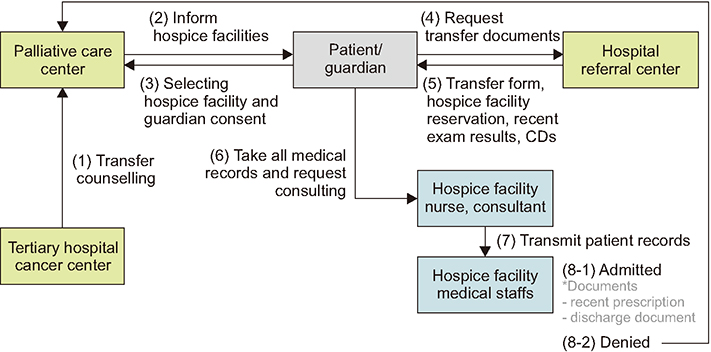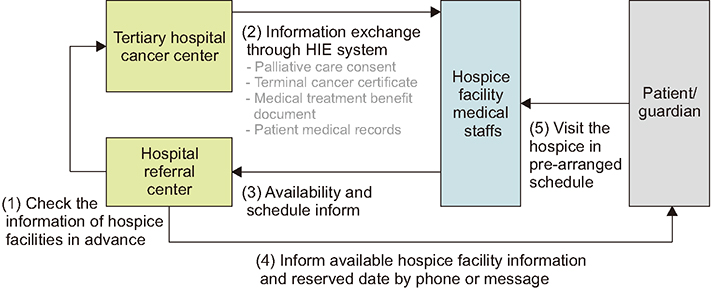Healthc Inform Res.
2018 Oct;24(4):317-326. 10.4258/hir.2018.24.4.317.
Design of a Hospice Referral System for Terminally Ill Cancer Patients Using a Standards-Based Health Information Exchange System
- Affiliations
-
- 1Office of e-Health Research and Business, Seoul National University Bundang Hospital, Seongnam, Korea.
- 2Department of Otorhinolaryngology, Seoul National University Bundang Hospital, Seongnam, Korea.
- 3Division of Medical Oncology, Department of Internal Medicine, Yonsei Cancer Center, Yonsei University College of Medicine, Seoul, Korea. wb0707@yuhs.ac
- KMID: 2434547
- DOI: http://doi.org/10.4258/hir.2018.24.4.317
Abstract
OBJECTIVES
The demand for hospice has been increasing among patients with cancer. This study examined the current hospice referral scenario for terminally ill cancer patients and created a data form to collect hospice information and a modified health information exchange (HIE) form for a more efficient referral system for terminally ill cancer patients.
METHODS
Surveys were conducted asking detailed information such as medical instruments and patient admission policies of hospices, and interviews were held to examine the current referral flow and any additional requirements. A task force team was organized to analyze the results of the interviews and surveys.
RESULTS
Six hospices completed the survey, and 3 physicians, 2 nurses, and 2 hospital staff from a tertiary hospital were interviewed. Seven categories were defined as essential for establishing hospice data. Ten categories and 40 data items were newly suggested for the existing HIE document form. An implementation guide for the Consolidated Clinical Document Architecture developed by Health Level 7 (HL7 CCDA) was also proposed. It is an international standard for interoperability that provides a framework for the exchange, integration, sharing, and retrieval of electronic health information. Based on these changes, a hospice referral scenario for terminally ill cancer patients was designed.
CONCLUSIONS
Our findings show potential improvements that can be made to the current hospice referral system for terminally ill cancer patients. To make the referral system useful in practice, governmental efforts and investments are needed.
Keyword
MeSH Terms
Figure
Reference
-
1. Hemati Z, Ashouri E, AllahBakhshian M, Pourfarzad Z, Shirani F, Safazadeh S, et al. Dying with dignity: a concept analysis. J Clin Nurs. 2016; 25(9-10):1218–1228.
Article2. Jordhoy MS, Fayers P, Loge JH, Ahlner-Elmqvist M, Kaasa S. Quality of life in palliative cancer care: results from a cluster randomized trial. J Clin Oncol. 2001; 19(18):3884–3894.
Article3. De Palma R, Fortuna D, Hegarty SE, Louis DZ, Melotti RM, Moro ML. Effectiveness of palliative care services: a population-based study of end-of-life care for cancer patients. Palliat Med. 2018; 32(8):1344–1352.
Article4. Worldwide Palliative Care Alliance. Global atlas of palliative care at the end of life. London, UK: Worldwide Palliative Care Alliance;2014.5. Treating patients with cancer: reason for being popular, hospice care [Internet]. Seoul, Korea: Hankyung.com;2017. cited at 2018 Oct 1. Available from: http://news.hankyung.com/health/article?aid=201701020995a.6. Health Insurance Review & Assessment Service. Effect analysis of hospice care. Wonju, Korea: Health Insurance Review & Assessment Service;2018.7. Ji H, Yoo S, Heo EY, Hwang H, Kim JW. Technology and policy challenges in the adoption and operation of health information exchange systems. Healthc Inform Res. 2017; 23(4):314–321.
Article8. Wright AA, Zhang B, Keating NL, Weeks JC, Prigerson HG. Associations between palliative chemotherapy and adult cancer patients' end of life care and place of death: prospective cohort study. BMJ. 2014; 348:g1219.
Article9. HL7/ASTM Implementation Guide for CDA R2 - Continuity of Care Document (CCD) Release 1 [Internet]. Ann Arbor (MI): Health Level Seven International;c2018. cited at 2018 Oct 1. Available from: http://www.hl7.org/implement/standards/product_brief.cfm?product_id=6.10. Ministry of Health and Welfare. Guideline for adopting standard health information exchange. Seoul, Korea: Ministry of Health and Welfare;2017.11. Kernan R. Clinical Document Architecture (CDA), Consolidated-CDA (C-CDA) and their role in meaningful use (MU) [Internet]. Washington (DC): Office of the National Coordinator for Health Information Technology;2012. cited at 2018 Oct 1. Available from: https://www.healthit.gov/sites/default/files/resources/cda_ccda_theirrole_in_mu.pdf.12. Rhee YJ. Hospice and palliative care services in South Korea supported by the National Health Insurance (NHI) program. Health. 2015; 7:689–695.
Article13. Kim CG. Hospice & palliative care policy in Korea. Korean J Hosp Palliat Care. 2017; 20(1):8–17.
Article14. Park SK, Chwa YK, Kim M, Cho K, Kang D, Kim J, et al. Health information exchange standard adopting guideline. Cheongju, Korea: Korea Health Industry Development Institute;2017.15. van Oorschot B. Early integrated palliative care in cancer patients improves quality of life and encourages discussions about preferences for care at the end of life. Strahlenther Onkol. 2018; 194(2):178–180.16. Kisekka V, Giboney JS. The effectiveness of health care information technologies: evaluation of trust, security beliefs, and privacy as determinants of health care outcomes. J Med Internet Res. 2018; 20(4):e107.
Article17. Parker C, Weiner M, Reeves M. Health information exchanges: unfulfilled promise as a data source for clinical research. Int J Med Inform. 2016; 87:1–9.
Article
- Full Text Links
- Actions
-
Cited
- CITED
-
- Close
- Share
- Similar articles
-
- Development of Internet based Hospice Information Service System
- The Medical Costs in Terminally Ill Cancer Patients
- The Present Status and Problems in Terminal Cancer Care
- Needs of Hospice Care in Families of the Hospitalized Terminal Patients with Cancer
- The Comprehension of Hospice-Palliative Care and Self-determination Life Sustaining Decision-Making Act as Uro-Oncologist



